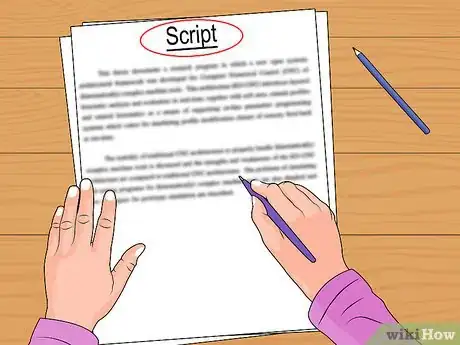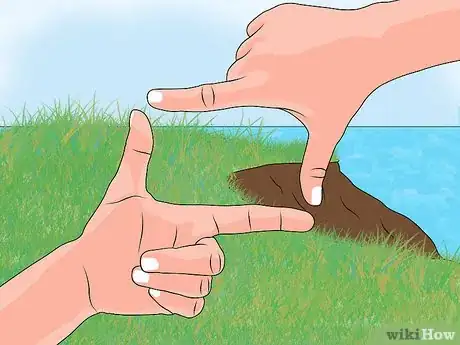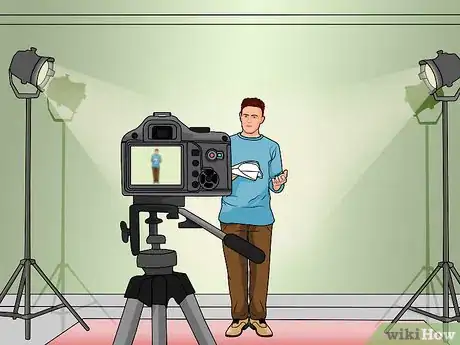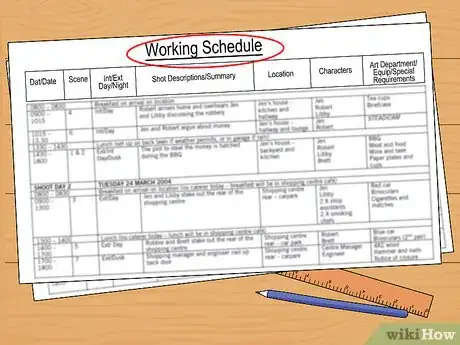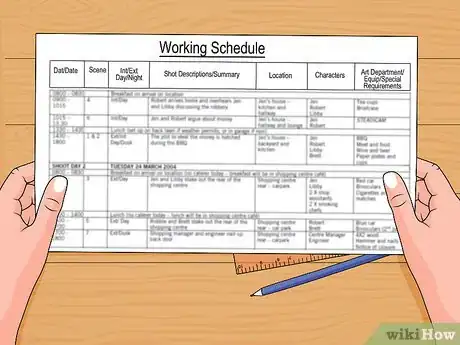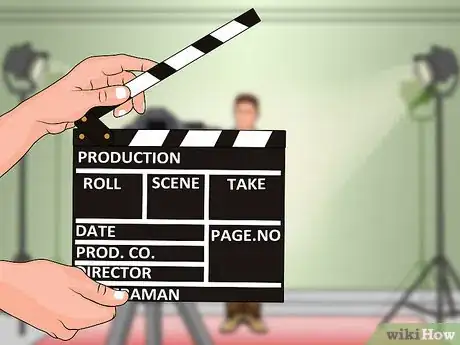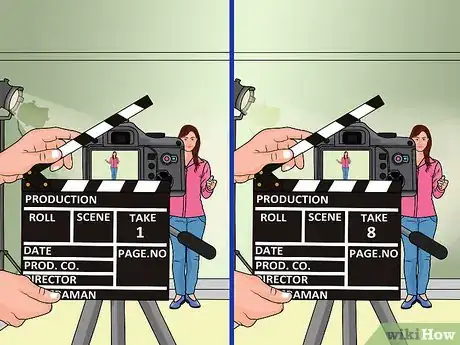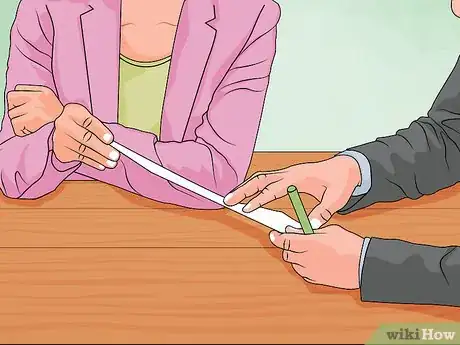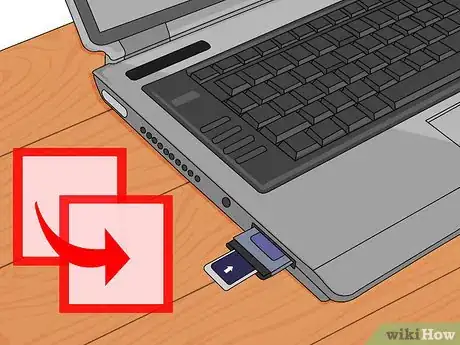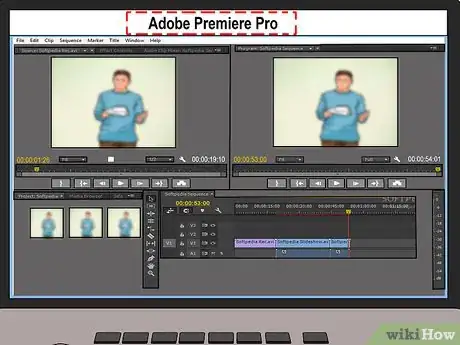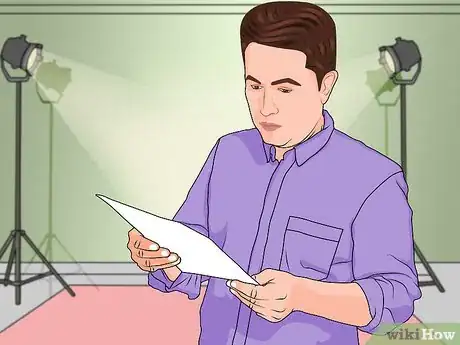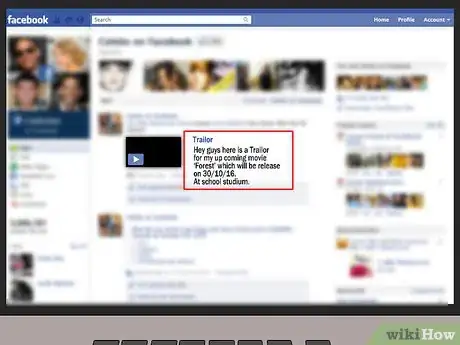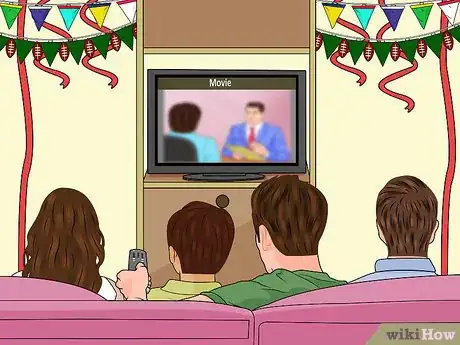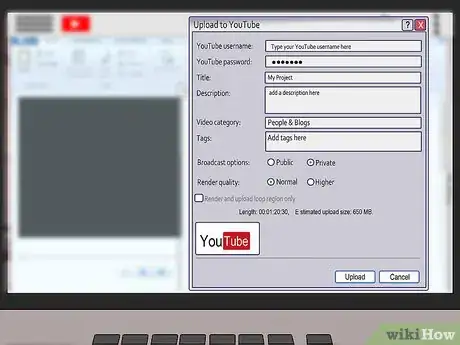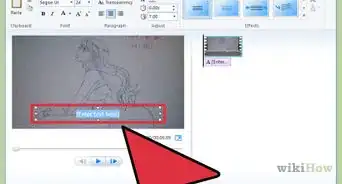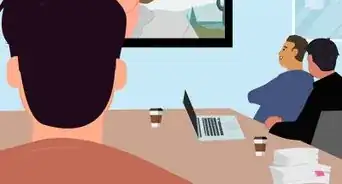This article was co-authored by Melessa Sargent. Melessa Sargent is the President of Scriptwriters Network, a non-profit organization that brings in entertainment professionals to teach the art and business of script writing for TV, features and new media. The Network serves its members by providing educational programming, developing access and opportunity through alliances with industry professionals, and furthering the cause and quality of writing in the entertainment industry. Under Melessa's leadership, SWN has won numbers awards including the Los Angeles Award from 2014 through 2021, and the Innovation & Excellence award in 2020.
There are 7 references cited in this article, which can be found at the bottom of the page.
This article has been viewed 67,235 times.
Making your own movie can be a fun way to spend a weekend with your friends, a great school project, or something you want to do for a living. You can make your own movie using simple equipment, like your phone or a digital camera, or with more advanced equipment that includes lighting and sound. There are several steps that go into making any film like cost, writing a script and getting a cast, shooting, and producing your movie. Even if you're not making a big-budget Hollywood film, you can easily make your own movie.
Steps
Planning Your Movie
-
1Figure out your budget. Decide how much money you can and want to use on your movie. If you’re making a movie that you plan to submit to festivals, you’re going to need to spend some money, even if it’s a micro-budget film. If you’re just making a fun film for you and your friends, you can get away with spending little or no money.
- A budget contributes to many factors when making a movie. You can spend money on lighting, sound, equipment, locations, wardrobe, actors, promotions, and more.
- Even micro-budget films can be pretty expensive if you’re using professional equipment and a crew. Micro-budget films can reach a cost of nearly $400,000. However, you can still make your own movie for a lot less.[1]
- Decide on a set amount you can spend. Then create a list on what’s most important to your movie. Maybe you have a camera and don’t need to purchase or rent one. You and your friends might decide that you will star in your movie, and don’t need to pay actors. You or your friends might know how to light a shot, and have some equipment already. This eliminates the need to purchase or rent more.
- It’s not hard to make a movie with little to no budget. However, investing some money in the right areas can greatly increase the quality of your movie.[2]
- Sound and lighting are two aspects to making a movie that can really affect the quality. Proper lighting can counteract a cheaper camera. Sound is one of the most important qualities in a film. If your actors can’t be heard, or there’s too much background noise, the entire movie suffers. Consider investing in lav mics and sound equipment. Lavalier mics are wireless microphones that you clip to your actors to catch a crisper sound.
- If you decide that you need to earn some money to make a movie, consider launching a crowdfunding campaign to raise funds.
-
2Come up with a plot. Now that you know what your budget looks like, you can start coming up with an idea for your film. Create a plot that you can realistically shoot on your budget. This means that you may not be able to include a lot of visual effects, like explosions, but you can write a script that works around that. Start developing your plot by thinking about the who, what, when, where, why.
- Create a summary of your plot in two sentences. In your first sentence address the protagonist and the conflict. Your second sentence should cover what happens.
- For example, your first sentence could be something like: “Danny has been in love with Lisa since freshman year, with senior prom fast approaching, he has one last chance to show Lisa how he feels.” This sentence explains who the main character is, what that character wants, and why it’s important.
- Your second sentence could be: “When he learns that almost every other guy in class plans on asking Lisa to prom, Danny enters a race of epic proportions to be the guy Lisa says yes to.” This sentence is like a logline and explains in more depth what will happen during the film.
- Next, flesh out the rest of the details. Fill in who the secondary characters are. Where the film is set, and other details.
- Divide your plot into three parts or acts. You should have a beginning, middle, and end. With our example film, the beginning could be the spring of senior year. Our character Danny decides he must finally muster the courage to ask Lisa to prom. The middle covers Danny enacting the plan and trying to beat out Lisa’s other suitors. The end is when Danny finally wins and takes Lisa to prom.
Advertisement -
3Write your script. With a well-rounded idea of what your movie is about, and what your budget is, it’s time to write a script. In a film script, about one page of text equals one minute of film. Decide how long you want your movie to be. If you are making a movie for a school project or festival you may have specific time limits. If this is just for fun, you might want to stick to a shorter script to make the movie easier to produce. There are several main aspects to writing a script that will help you produce a great movie.[3]
- Start with the setup. The first ten percent of your script deals with drawing the viewer into the world of your movie. Establish the characters, the main location, and everyday life. In our example film, this could show our character Danny at school in the hallway or in class. Maybe Danny walks down the hallway talking to Lisa before Lisa gets swept away by some friends. Then Danny’s best friend comes up and the two talk about Danny’s love for Lisa. Moments later in class, the school announcements tell everyone about the upcoming prom. Then we see something that shows the audience how everyone plans to ask Lisa to Prom.
- Transition to the new situation. The next fifteen percent of your script deals with how your character reacts to this change in the world. In our example film, Danny decides to get a group of friends together to come up with a plan to ask Lisa to prom.
- The change of plans comes next, about twenty-five percent in. Something must happen that causes your character to adapt and change, adopting a new course of action. Since this is a movie, and should be fun, feel free to play with a bit of fantasy here. In our example film, Lisa could decide that whomever comes up with the most creative prom proposal will become the winning date. This causes Danny to have to come up with a new, grander proposal than before.
- Progress your script along with events going seemingly well until you reach the halfway point. Then you’ve reached the point of no return. Your character will have to make a choice that resembles a transformation. For example, Danny might confront another boy who is more popular that plans to ask Lisa to prom. Perhaps the other boy humiliates Danny, warning Danny to back off, or steals Danny’s plan. Now Danny must decide if he will retaliate against this new enemy, or focus more on Lisa. Either way, Danny now faces being the laughing stock of the school, and potentially getting beat up by the other boy and his friends.
- The next 25 percent of your movie should involve this new goal getting harder and harder to achieve. Perhaps Danny starts doing poorly in school. Coming up with this grand gesture of love has made Danny’s grades suffer. If Danny can’t do better in school, he won’t even be allowed to go to prom.
- Continue to escalate the struggles your character faces until the last ten percent of your script. In our example film, Danny could flunk another test that not only means he may not be able to go to prom, but Danny might not even be able to graduate. Perhaps Danny’s friends drop out and stop helping. This could lead to Danny questioning whether all the efforts were even worth it.
- When all hope seems lost, you reach the climax. This is the biggest part of your movie where everything comes together. Danny has focused on getting better grades and in doing so has learned something from a class that inspires Danny to come up with the ultimate proposal. Not only does Danny convince his friends to help him again, but he makes a grand gesture that simultaneously exposes the other boy as a bully, and gets Lisa to go to prom with him.
- Finally, you come to the aftermath. This is where you explain what happens after the big event. Danny takes Lisa to prom. The two graduate and spend a wonderful summer together.
- Depending on the length of your movie. Each section may be several minutes, or one quick scene. If you are making a short film, it’s ok to cut some of the middle parts out.
-
4Assemble a crew. With a script in hand, and a budget set, it’s time to get all the people you plan on using to shoot your movie together. Look at the equipment you’re going to use and figure out who is going to operate each piece of equipment.
- Do you need someone to operate the camera, or will you do it yourself?
- If you’ve invested in sound equipment, it’s best to have a person whose sole job is to operate the audio equipment.
- If you are just making a movie with your friends, then you can easily divide up the different roles amongst yourselves.
- It’s important to make sure that you have everyone on board before you actually shoot your movie, so it can go as smoothly as possible.
-
5Find a location. After you’ve written your script and you know how many characters and people working on the set you’ll have, find a location. You’ll have to make sure that you get permission to film in your chosen location, and that it can fit everyone.
- For smaller budget films, or ones you’re just making with your friends, look for locations you know you can use for free first. This could be your friend’s house or yours, your school, or even a park.
- If you need to shoot somewhere like at a restaurant or store, this could be trickier to accomplish. You’ll have to get permission from the owner. Additionally, places like this will want you to pay them to film.
-
6Cast your actors. Once you have everything set up and are almost ready to film, you need to get some actors. If you are making a movie for school, or fun, you can use your friends. If you want a more professional looking film, consider auditioning actors.
- Even if you’re making a film for a school project, consider holding auditions at school. Ask your teacher or the head of the theatre department to let you hold auditions.
- When having actors audition, record the auditions so you can view the tapes letter to make a decision. This will also help you see how well the actor plays on camera.
- Provide sides for the actors ahead of time. Sides are a few pages of your script that you give your actors to read for the audition. Look for parts of your script that don’t give a lot about the movie away. You want to see the choices the actors make when the subject is vague. The best sides are ones that depict a relationship between two people.
-
7Make a schedule. With everyone on board, you can now make a schedule that works for everyone. Make sure you give yourself enough time to get set up, shoot, and cleanup.
- Even if you’re making a fun movie and are not on a timeline, a schedule is imperative to keep everything on track. If you are working with a deadline, it’s even more important, as everything from the mood of your cast and crew to your potential budget will be affected.
- A big budget film that is working properly can shoot at most six pages of a script per 12-hour day. Chances are you don’t have that luxury, so you have to scale down. Try to shoot two or three pages a day.
- If your film is shorter and uses only one or two locations, you can do more. Plan to shoot all of the locations together. In our example film, your locations may include Danny’s house, and the school. Shoot all of the stuff at school at one time, then the house.
- Even with a short film, plan to spend a couple of hours shooting each day. You want to have ample time to set up, rehearse, and get a few takes in for each shot.
Shooting Your Movie
-
1Use good equipment. Using great equipment can easily get very expensive. But you don’t need to use extremely expensive equipment to make a good film. You can even shoot a great movie on your phone, if you have a newer one with a nice camera.
- Having a proper camera is great, and if you have the budget for one, consider renting before buying. Ask people you know if anyone has a camera you can use. If you’re shooting for a school project, see if the school has any equipment. If all else fails and you have newer phone, your phone’s camera may be enough.
- Get a tripod for your camera. You need something to stabilize your camera so that your shots don’t look shaky and blurry. There are even extensions for phones to make the lenses better and tripods to hook your phone into.
- Try to get some kind of audio equipment. A low budget film will be better if the sound is crisp and clear. Consider getting lav mics for your actors, or at least a boom mic to record sound.
- Use lighting equipment. Like sound, lighting plays an important role. No matter how nice your camera is, if the lighting looks bad, so will your movie. If you don’t have the budget for lamps and other lighting equipment, get a white umbrella that you can use to reflect light and soften hard fluorescent lights. Camera’s don’t view light like our eyes do. Cameras see more contrast, lighting a scene properly can make a shot look more natural to the eye.
-
2Follow your schedule. Keeping to your schedule will help you keep your movie moving forward. A lot can happen when filming and you may have to make adjustments.
- Your schedule will help you to focus on getting the right shots and filming the right scenes when you’re supposed to.
- A schedule will also help you make sure that you film all of your scenes. You don’t want to start editing your movie and realize you don’t have a scene.
-
3Slate your shots. No matter how big or small your movie is, slating each shot will be a huge help when it comes time to edit. You don’t need a fancy board to slate your shots either, you can simply use paper, or a dry erase board.
- Dry erase boards work better than paper because you want to be able to mark which take you are doing.
- For each shot, write down at least the scene number, what take your on, and if even what page you’re shooting. This information allows you to easily know what the content is when editing.
- You also want to clap so you can sync your video and sound up. By clapping you know where to begin cutting your footage when you’re editing. You’ll be able to hear the clap on both your video file, and your separate audio file.
-
4Get enough takes. When shooting, make sure to get enough takes of each shot. You want to have options to work with when editing.
- You might find that when you changed the lighting in one shot, or told the actors to do something different, you got a really good result.
- Some directors only do one take, though it’s rare, and you don’t have to get three or four takes for every shot. But be prepared to so you have options.
-
5Improvise. Making a movie should be fun. And you should follow your plan as much as possible, but you may find along the way that a new location works better. Your actors may make a joke that you think fits into your movie. Learn to go with the flow.
- Being able to improvise will also make the experience for everyone much more enjoyable. No one wants a director or someone who can’t listen to people and make changes.
Editing Your Movie
-
1Load all of your files onto your computer. Now that you have all of your footage from your camera and your sound recorder, it’s time to put it on your computer. Take the SD cards that have your footage stored and transfer the files over to your computer.
- It’s easiest to create a folder that you can title whatever your movie is titled on your desktop. Then, create a folder for video, and one for audio.
- If you used your phone to shoot your movie, you can plug your phone into your computer and transfer the files directly. Or if you have a phone with an SD card, remove it from your phone and place it in your computer to transfer the files.
-
2Use an editing software. To edit your film, you need a program that you can load all of your files into. There are paid applications like Adobe Premiere Pro that can do a lot of very advanced editing. However, your computer usually has its own editing software that’s free for you to use.
- If you are on a Mac, you can use iMovie to edit your movie.
- If you are on a Windows, you can use Windows Movie Maker.
- If you have audio files, you have to line those files up with the corresponding shots. This could take some time to get used to doing. It’s best to have all of your video files in place and set before adding sound. Once you have each one paired with the shot, make sure to clip the files together so that if you move one, the other goes with it.
-
3Follow your script. To help you edit your movie so that it has a continuous flow, follow along with your script. You may think you remember each part and scene, but if you are working with a lot of files you can lose track. Go page by page and find the corresponding scene.
- Insert your scenes in chronological order of the events in the movie first. Once you have each scene in place, watch your movie. You may find that one scene you thought worked better later in the film now makes more sense towards the beginning.
- Cut out empty space in your scenes. As you progress along, you may find that certain shots or lines of dialogue don’t provide much value. Cut those extra, unneeded parts out to keep the flow your movie engaging.
-
4Get a second opinion. Once you’ve edited your movie, get your friends, and other people who worked on it to see the product. Getting another opinion can help you to find parts you could change that you overlooked.
- You don’t have to let everyone watch your movie before it’s completely finished, but a trusted second pair eyes can be a big help.
- You can also hire an editor, or hand the footage off to one of your friends who is skilled in editing. Another person may be able to work more with color correction and sound mixing to refine your movie more.
Releasing Your Movie
-
1Export your film to a video file. When the editing is finally complete, it’s time to export your film. Think about where you want your film to be seen as this might determine how you export it.
- There are a lot of exporting options and file types. Some codecs are of a higher quality than other, and they may also differ from application to application. Think about what device your video will play on, and where.
- If you want to put your movie online to Vimeo or YouTube, a good codec (the format your video is encoded in) is H.264. This is a high definition file format that will look great online, and come out as an mp4.[4]
- If you are exporting your film to burn to DVD, you want to export as H.264 Blu-ray. This will allow you to easily burn your movie to a DVD.
- If you plan to submit your movie to festivals you may need to export your movie as a DCP file. However, you typically need another program such as OpenDCP to export your film. This file is really only for professional movie projectors found in theaters.
- If you plan to watch your movie on your computer or with an HDMI cable, you can choose QuickTime, or AVI outputs.
- Export a small sample of your movie before exporting the whole thing to see how it looks and sounds. This will allow you to make any changes on a smaller file before spending hours exporting your whole movie before realizing you have to do it over again.
-
2Create a social media page and buzz. If you’re going to release your movie in any way to the public, you want to create buzz. Even if you’re making this movie for a school project, create a social media page on Facebook to promote it and provide information on when and where people can watch it.
- Go to Twitter and create a profile or hashtag that you can tweet out with updates.
- Create a trailer so people have something to see before you release the whole movie.
- If you’re not just making a fun film for you and your friends to enjoy, treat your movie like it’s a Hollywood movie. Hype it up and raise awareness.
-
3Design a poster. If you’re showing your film somewhere, create a poster for your movie that tells people where and when it’s going to be showing. Make your title prominent, and use an engaging image that shows what the movie might be about.[5]
- Look at the posters from some of your favorite movies for comparison. These posters can inspire you and give you a template to go off of.
- Avoid making your poster too many colors. A few colors like in the title and on the image can draw the eye to the right place. Too many colors can distract.
- Consider using artwork instead of a photo. Sometimes an illustration can be more intriguing than a photo.
- Get an expert to help you. If you need a poster for something like a festival, then consider hiring someone like a graphic artist to design your poster.
-
4Hold a screening. Whether it’s at school, a festival, or in your home, celebrate the fact that you made a movie. Hold a screening with at least the people that worked on it so you can all enjoy your work.
- If you’re at home, get out some snacks and pretend you’re in a large movie theatre by turning down the lights. Try and experience your movie the way you would if it were a Hollywood blockbuster.
- After your screening you can ask the people that watched it for thoughts and opinions on the film. Then, if you want to, you can make edits before the final version.
-
5Upload your movie online. If you’re proud of your film, upload it to YouTube or Vimeo. You can always keep it private if you don’t want the public to see it.[6] [7]
- Uploading your movie and promoting it is a great way to build your portfolio and resume if you are trying to get in the business of filmmaking.
- If you make a movie you are really proud of and to share or submit to festivals, having it online is an extremely easy way to do so.
- If you don’t want to share your video with everyone, keep it private and only hand out the link to people you’re ok with watching it. It may be fun to look back on and watch years later.
Expert Q&A
-
QuestionHow do you make a good chase scene?
 Melessa SargentMelessa Sargent is the President of Scriptwriters Network, a non-profit organization that brings in entertainment professionals to teach the art and business of script writing for TV, features and new media. The Network serves its members by providing educational programming, developing access and opportunity through alliances with industry professionals, and furthering the cause and quality of writing in the entertainment industry. Under Melessa's leadership, SWN has won numbers awards including the Los Angeles Award from 2014 through 2021, and the Innovation & Excellence award in 2020.
Melessa SargentMelessa Sargent is the President of Scriptwriters Network, a non-profit organization that brings in entertainment professionals to teach the art and business of script writing for TV, features and new media. The Network serves its members by providing educational programming, developing access and opportunity through alliances with industry professionals, and furthering the cause and quality of writing in the entertainment industry. Under Melessa's leadership, SWN has won numbers awards including the Los Angeles Award from 2014 through 2021, and the Innovation & Excellence award in 2020.
Professional Writer Set the camera in one spot, and then set another camera in a separate place so the car approaches the camera in a turn. You can really set up cameras all over the place so that you have every view of the chase scene filmed. Once the cars are in motion, you can just edit.
Set the camera in one spot, and then set another camera in a separate place so the car approaches the camera in a turn. You can really set up cameras all over the place so that you have every view of the chase scene filmed. Once the cars are in motion, you can just edit. -
QuestionCan you make your own animated movie?
 Melessa SargentMelessa Sargent is the President of Scriptwriters Network, a non-profit organization that brings in entertainment professionals to teach the art and business of script writing for TV, features and new media. The Network serves its members by providing educational programming, developing access and opportunity through alliances with industry professionals, and furthering the cause and quality of writing in the entertainment industry. Under Melessa's leadership, SWN has won numbers awards including the Los Angeles Award from 2014 through 2021, and the Innovation & Excellence award in 2020.
Melessa SargentMelessa Sargent is the President of Scriptwriters Network, a non-profit organization that brings in entertainment professionals to teach the art and business of script writing for TV, features and new media. The Network serves its members by providing educational programming, developing access and opportunity through alliances with industry professionals, and furthering the cause and quality of writing in the entertainment industry. Under Melessa's leadership, SWN has won numbers awards including the Los Angeles Award from 2014 through 2021, and the Innovation & Excellence award in 2020.
Professional Writer It's possible! You can either figure out how to create the animated characters yourself, or you can hire someone that does animation.
It's possible! You can either figure out how to create the animated characters yourself, or you can hire someone that does animation. -
QuestionI want to share my movie, but I cannot use YouTube until I'm 15. I don't want to post it on Facebook, and I don't want just my family to watch it. Are there other ways to share a movie with the world?
 Community AnswerYou can display it at a film festival. Alternatively, you can join a film club at your school and show the movie there.
Community AnswerYou can display it at a film festival. Alternatively, you can join a film club at your school and show the movie there.
Expert Interview

Thanks for reading our article! If you'd like to learn more about making a movie, check out our in-depth interview with Melessa Sargent.
References
- ↑ https://stephenfollows.com/average-budget-low-micro-budget-film/
- ↑ http://www.premiumbeat.com/blog/how-to-create-a-low-budget-film-that-feels-like-a-blockbuster/
- ↑ http://www.storymastery.com/story/screenplay-structure-five-key-turning-points-successful-scripts/
- ↑ https://vimeo.com/help/compression
- ↑ http://www.chrisjonesblog.com/2012/11/how-to-design-a-movie-poster-%E2%80%93-top-ten-tips-to-grab-the-eye-of-a-sales-agent-distributor-or-audience-member.html
- ↑ https://support.google.com/youtube/answer/57407?hl=en
- ↑ https://vimeo.com/help/faq/uploading-to-vimeo
About This Article
Making your own movie can easily be done using your phone or a digital camera, a homemade script, and your friends for actors. To start, establish where you want to film, who your characters will be, and what the main story of your film will be. Then, write out a script, including the dialogue and action of each scene. When you start filming, be sure to get a few takes of each shot in case you find a problem when you’re watching the footage. Once you’ve filmed everything, load your files onto a computer, and use a program like iMovie or Windows Movie Maker to put everything together. If you want to use more advanced editing you can also purchase software like Adobe Premiere Pro. To learn how to host a screening for your finished movie, read on!


